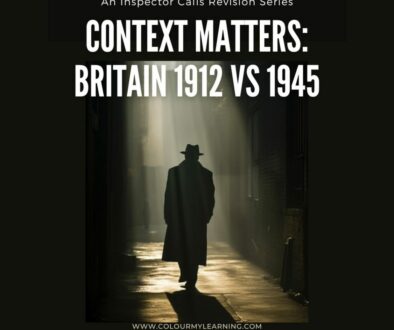IGCSE Physics Waves Past Papers Exam Questions (Edexcel): 2021-22
We analysed the International GCSE past papers and grouped the questions by topic. Here, you will find questions relating to the topic – Waves. Use these to familiarise, practice and prepare for your IGCSE Physics examination.
You can find more IGCSE Physics Past Year Questions by the Wave topic below:
- Waves Past Papers from 2019 to 2020
- Waves Past Papers from 2021 to 2022
- Waves Past Papers from 2023 to 2024
What you need to know
Use the list below as a quick recap for what you need to know before attempting the past year exam questions under this topic. This is based on Edexcel International GCSE in Physics (4PH1) specification with first teaching Sept 2017 and first examination June 2019.
Paper 1 and 2: (3) Waves
Paper 1 covers all the topics except where it is marked “paper 2 only” while Paper 2 covers all topics.
A. UNITS
- degree (°), hertz (Hz), metre (m), metre/second (m/s) and second (s)
B. PROPERTIES OF WAVES
- explain differences between longitudinal and transverse waves.
- definitions of amplitude, wavefront, frequency, wavelength and period of a wave.
- waves transfer energy and information without transferring matter.
- the relationship between wave speed, wavelength and frequency. v=f×λ
- the relationship between frequency and time period. f=1/T
- use the relationships above in different contexts
- the Doppler effect: change in observed frequency and wavelength when its source is moving relative to observer
- that all waves are reflected and refracted
C. THE ELECTROMAGNETIC SPECTRUM
- that light is part of a continuous electromagnetic spectrum: radio, microwave, infrared, visible, ultraviolet, x-ray, gamma ray.
- that all these waves travel at the same speeds in free space
- the order of electromagnetic spectrum by wavelength and frequency (decreasing wavelengths, increasing frequency, colours of visible spectrum)
- explain the uses of electromagnetic radiations: radio waves (broadcasting, communications), microwaves (cooking, satellite transmissions), infrared (heaters, night vision), visible light (optical fibres, photography), ultraviolet (fluorescent lamps), x-ray (observe internal structure, medical), gamma rays (sterilising food, medical equipment)
- explain the detrimental effects of the electromagnetic waves: microwave (internal heating of body tissue), infrared (skin burns), ultraviolet (damage to surface cells and blindness), gamma ray (cancer, mutation). Describe protective measures.
D. LIGHT AND SOUND
- that light waves are transverse waves and can be reflected and angle of refracted
- use the law of reflection. (angle of incidence = angle of reflection)
- draw ray diagrams to show reflection and refraction
- investigate the refraction of light
- the relationship between refractive index and the angle of incidence and angle of refraction. n = sin i / sin r
- investigate the refractive index using glass block
- describe the role of total internal reflection in optical fibres and prisms
- explain the meaning of critical angle, c
- relationship between critical angle and refractive index. sin c = 1 / n
- sound waves are longitudinal and can be reflected and refracted
(paper 2 only)
- range of human hearing 20-20000Hz
- investigate the speed of sound in air
- how an oscilloscope and a microphone can display sound waves
- investigate the frequency of sound with an oscilloscope
- that pitch of sound relates to frequency of the source vibration
- that loudness relates to the amplitude of the source vibration
January 2021 Paper 1P Q9
9. A student does an investigation to determine the refractive index of a block made from flint glass
(a) She directs a ray of red light at the block, as shown in diagram 1.
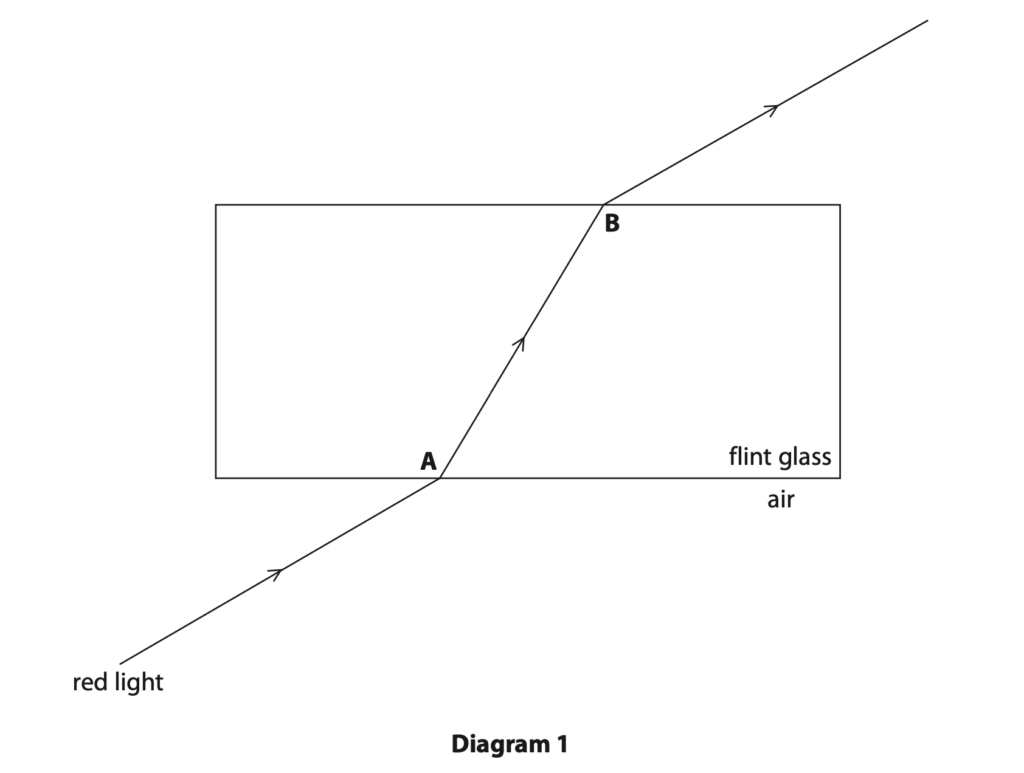
(i) Some of the light is reflected from the surface of the block at point A.
On diagram 1, draw this reflected ray of light. (1)
(ii) Use a protractor to determine the angle of incidence and the angle of refraction of the red light at point A on diagram 1. (2)
angle of incidence = …………………………………………………… degrees
angle of refraction = …………………………………………………… degrees
(iii) State the formula linking refractive index, angle of incidence and angle of refraction. (1)
(iv) Calculate the refractive index of the glass for red light. (2)
refractive index = ……………………………………………………
(v) Describe how the student could improve her investigation to obtain a more reliable value of the refractive index. (3)
(b) The student replaces the red light with a blue light.
Diagram 2 shows a ray of blue light directed at point A, at the same angle of incidence as the previous ray of red light.
The dashed lines on diagram 2 show the previous path of the ray of red light.
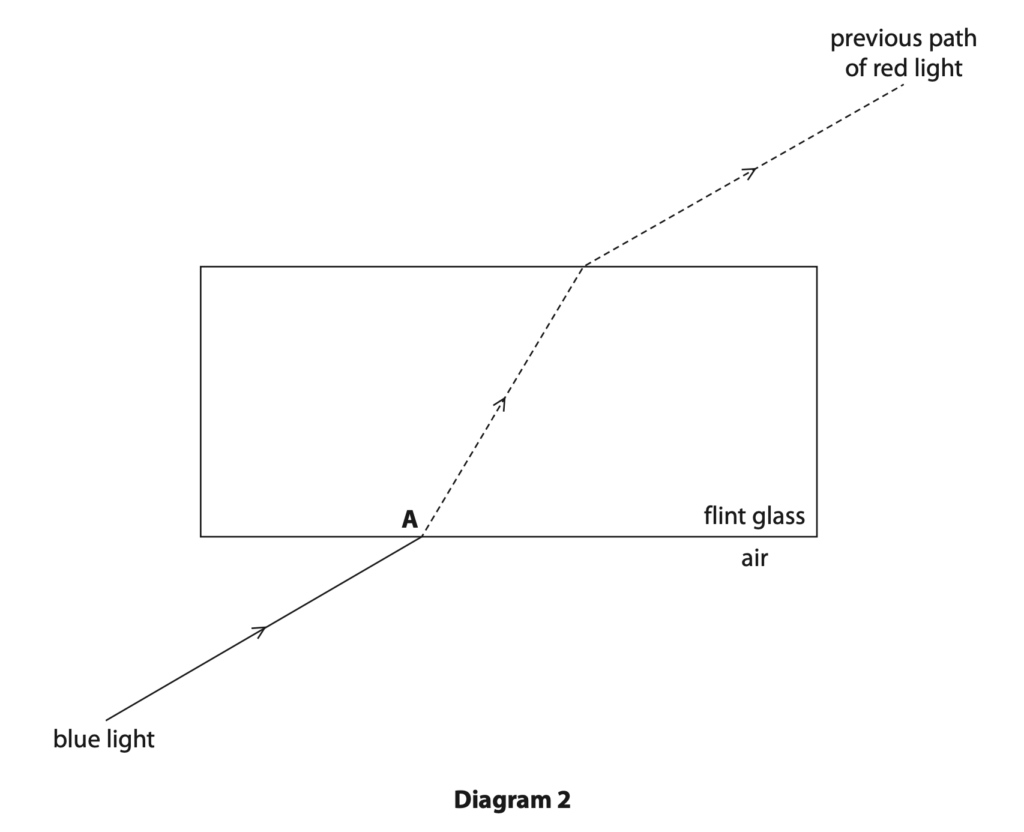
The refractive index of flint glass for blue light is higher than the refractive index of flint glass for red light.
Complete diagram 2 by drawing the path of blue light from point A until it passes into air. (3)
(Total for Question 9 = 12 marks)
January 2021 Paper 2P Q1
1 The photograph shows a security camera.
The camera detects light waves and sound waves.
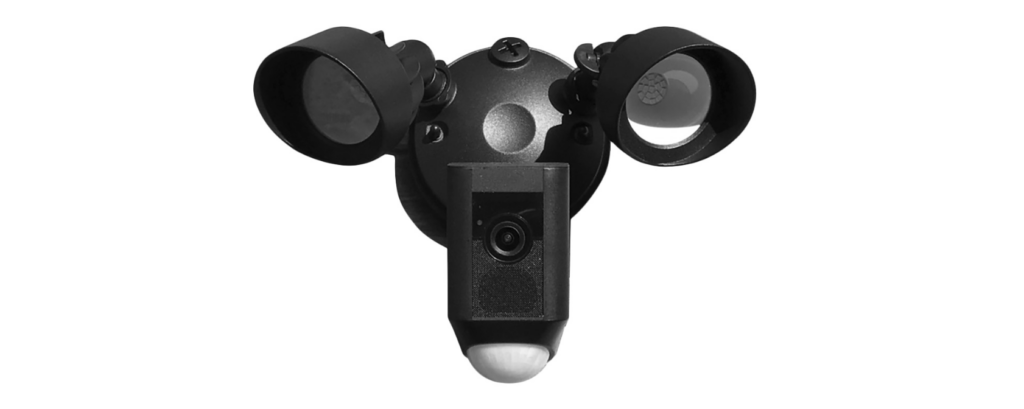
(a) State two differences between light waves and sound waves. (2)
1
2
(b) The camera detects infrared waves, which allow the camera to record videos in the dark.
(i) Which of these electromagnetic waves has a longer wavelength than infrared waves? (1)
A gamma rays
B microwaves
C ultraviolet rays
D visible light waves
(ii) Which of these is another use for infrared waves? (1)
A fluorescent lamps
B heating lamps
C satellite transmissions
D sterilising medical equipment
(iii) Which of these is a harmful effect of infrared waves? (1)
A blindness
B cancer
C internal heating of body tissue
D skin burns
(c) The grid shows the oscilloscope trace for a quiet, low-pitch sound wave.
The security camera has an alarm that produces a loud, high-pitch sound.
On the grid, draw a trace to represent the sound wave produced by the alarm. (2)

(Total for Question 1 = 7 marks)
January 2021 Paper 1PR Q6
6 The diagram shows a ray of light travelling from air into glass.
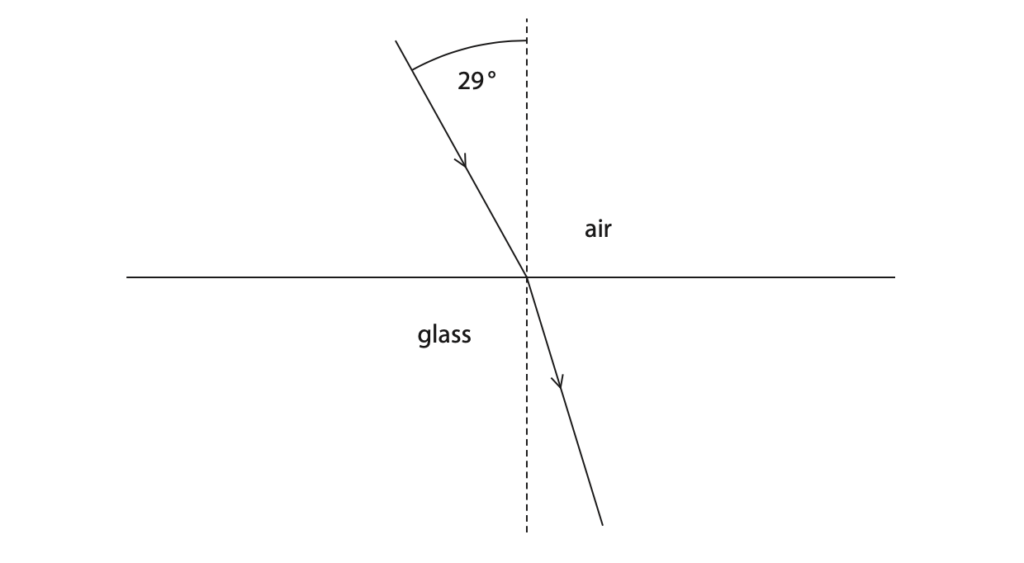
(a) Use a protractor to determine the angle of refraction. (1)
angle of refraction = …………………………………………………….. degrees
(b) State the formula linking refractive index, angle of incidence and angle of refraction. (1)
(c) Calculate the refractive index of this glass. (3)
refractive index = ……………………………………………………..
(Total for Question 6 = 5 marks)
January 2021 Paper 1PR Q9
9 The diagram shows two students holding a piece of string with a box attached.
The box has a buzzer inside and can move along the string.

The buzzer in the box emits a loud sound of constant frequency.
The box moves away from student A at a constant speed.
Explain why the sound heard by student A has a different frequency to the sound emitted by the buzzer. (5)
(Total for Question 9 = 5 marks)
January 2021 Paper 2PR Q4
4 (a) A student uses an oscilloscope to determine the speed of sound.
The diagram shows the oscilloscope trace produced by the sound wave.
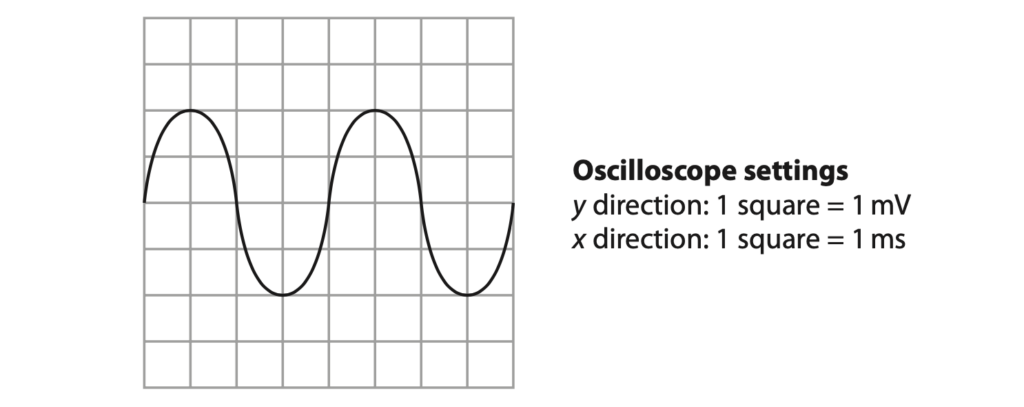
The student uses two microphones and a ruler to determine the wavelength of the sound wave.
He finds that the wavelength is 1.4 m.
(i) State the formula linking the speed, frequency and wavelength of a wave. (1)
(ii) Use the oscilloscope trace to calculate the speed of the wave. (5)
speed = …………………………………………………….. m/s
(b) Another student uses this method to determine the speed of sound.
Step 1 The student stands 50 m away from her teacher, measuring the distance with a metre ruler.
Step 2 The teacher makes a loud sound and flashes a light at the same time.
Step 3 The student starts the stopwatch when she sees the flash of light.
Step 4 She stops the stopwatch when she hears the loud sound
The speed of sound is calculated using the formula
Speed of sound = distance / time taken
Evaluate whether this method could produce an accurate value for the speed of sound in air. (5)
(Total for Question 4 = 11 marks)
2022 Paper 1P Q3
3 Wi-Fi signals are electromagnetic waves that can be transmitted at frequencies of 2.4 GHz and 5.2 GHz.
(a) (i) State a similarity of the Wi-Fi signals at 2.4 GHz and 5.2 GHz. (1)
(ii) The two Wi-Fi signals have different frequencies.
State another difference between the Wi-Fi signals. (1)
(b) (i) State the formula linking speed, frequency and wavelength. (1)
(ii) Calculate the wavelength of Wi-Fi signals transmitted at 5.2 × 109 Hz. (2)
[speed of light = 3.0 × 108 m/s]
wavelength = …………………………………………………….. m
(c) (i) Which type of wave is a Wi-Fi signal? (1)
A longitudinal
B mechanical
C sound
D transverse
(ii) Describe the difference between a transverse wave and a longitudinal wave. You may draw a diagram to help your answer. (2)
(Total for Question 3 = 8 marks)
2022 Paper 1 Q4
4 A student investigates the reflection of light by a plane mirror.
The student uses a ray box, a ruler, a pencil and a mirror.
(a) Name the apparatus that can be used to measure angles during the investigation. (1)
(b) The diagram shows a ray of light directed to a point on the mirror.

(i) Label the angle of incidence. (1)
(ii) Measure the angle of incidence. (1)
angle of incidence = …………………………………………………….. degrees
(iii) Complete the diagram to show the ray reflected from the mirror. (2)
(Total for Question 4 = 5 marks)
2022 Paper 1P Q10
10 Diagram 1 shows a ray of violet light entering a prism.
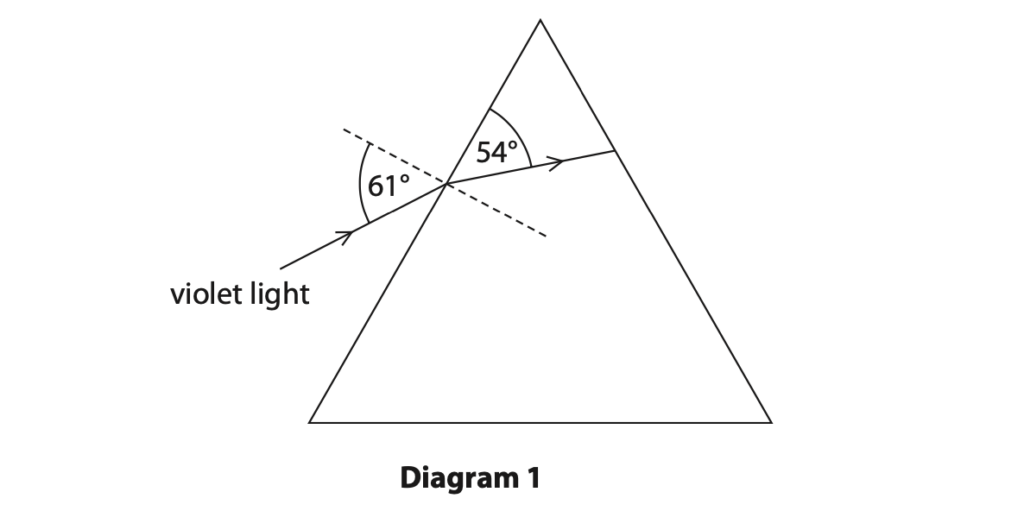
(a) (i) Calculate the angle of refraction for the violet light. (1)
angle of refraction = …………………………………………………….. degrees
(ii) State the formula linking refractive index, angle of incidence and angle of refraction. (1)
(iii) Calculate the refractive index of the prism for violet light. Give your answer to 2 significant figures. (3)
refractive index = ……………………………………………………..
Diagram 2 shows rays of red light and violet light entering the same prism.
Red light has a longer wavelength than violet light.
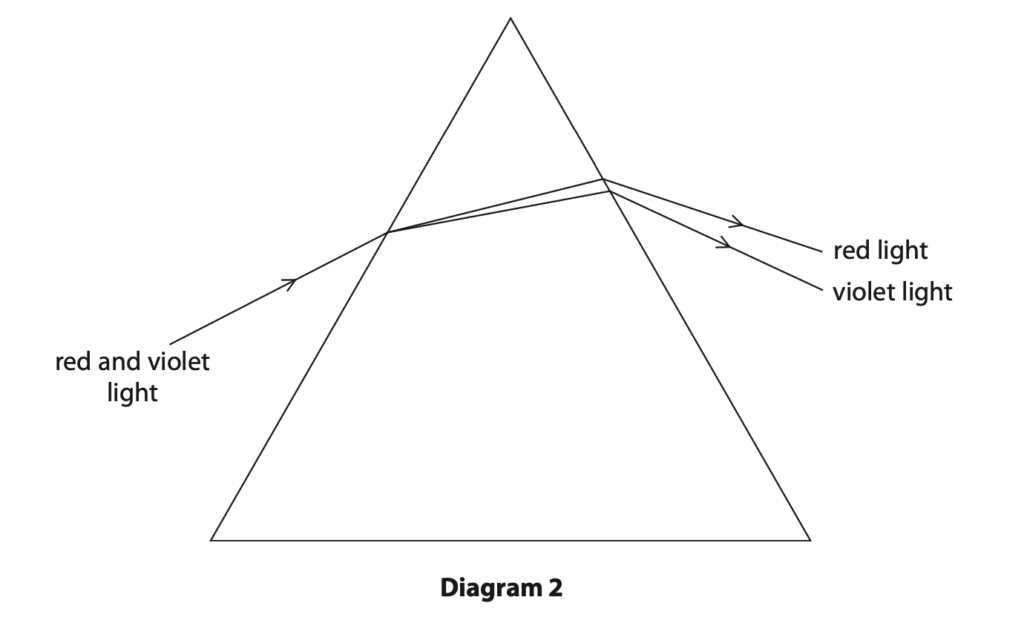
(b) Deduce a possible relationship between the wavelength and the refractive index for colours of the visible spectrum. (3)
(Total for Question 10 = 8 marks)
2022 Paper 1PR Q2
2 X‐rays and gamma rays are examples of ionising radiation.
(a) Which of these is another example of ionising radiation?
A infrared
B microwave
C radio
D ultraviolet
(b) Give one use of x‐rays and one use of gamma rays. (2)
x-rays
gamma rays
(c) (i) State the formula linking speed, frequency and wavelength of a wave. (1)
(ii) Calculate the wavelength of a gamma ray with a frequency of 2.8 × 1019 Hz. (3)
[speed of gamma ray = 3.0 × 108 m/s]
wavelength = …………………………………………………….. m
(d) X‐rays and gamma rays are electromagnetic waves.
Which of these graphs is correct for waves travelling at a constant speed?
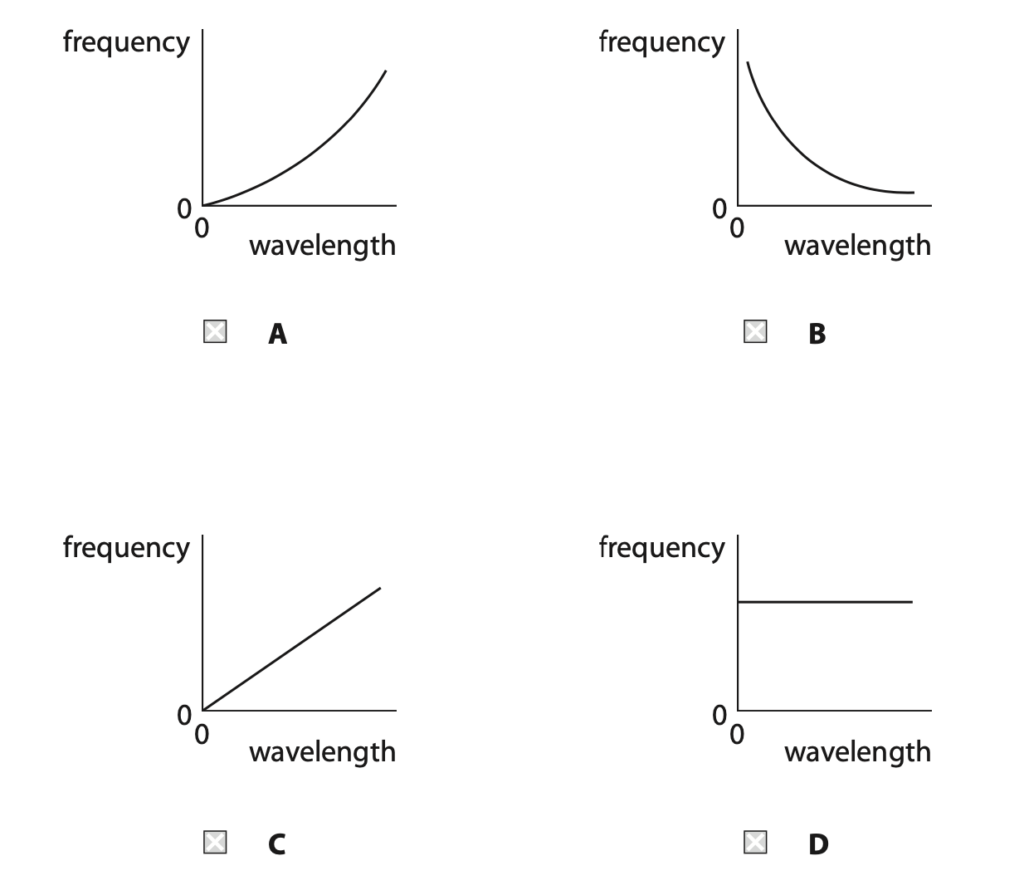
(Total for Question 2 = 8 marks)
2022 Paper 1PR Q7
7 (a) Describe an experiment to determine the refractive index of a glass block. (6)
In your answer you should include
- a labelled diagram
- the apparatus needed
- the method used
(b) Give two uses of total internal reflection. (2)
1
2
(Total for Question 7 = 8 marks)
2022 Paper 1PR Q8
8 (a) The diagram shows a fishing boat fitted with a high frequency sound wave emitter.
The boat is above some fish.
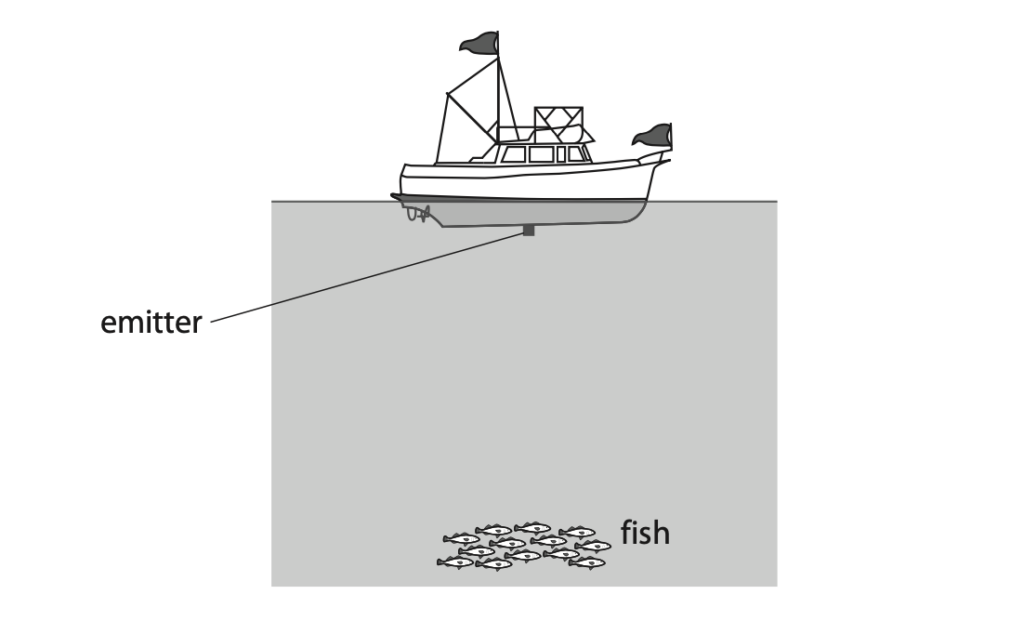
The high frequency sound waves travel from the emitter to the fish and then back to the emitter, where they are detected.
(i) Name the wave behaviour that causes the sound waves to change direction when they reach the fish. (1)
(ii) The table gives some data about the sound waves used.
| frequency of sound waves | 4.0 MHz |
| speed of sound waves in water | 1500 m/s |
| time between emission and detection of sound waves | 43 ms |
Calculate the distance between the sound wave emitter and the fish. (4)
distance = …………………………………………………….. m
(b) High frequency sound waves decrease in amplitude as they travel through soft tissue in the human body.
The graph shows this decrease in amplitude for three different high frequency sound waves.
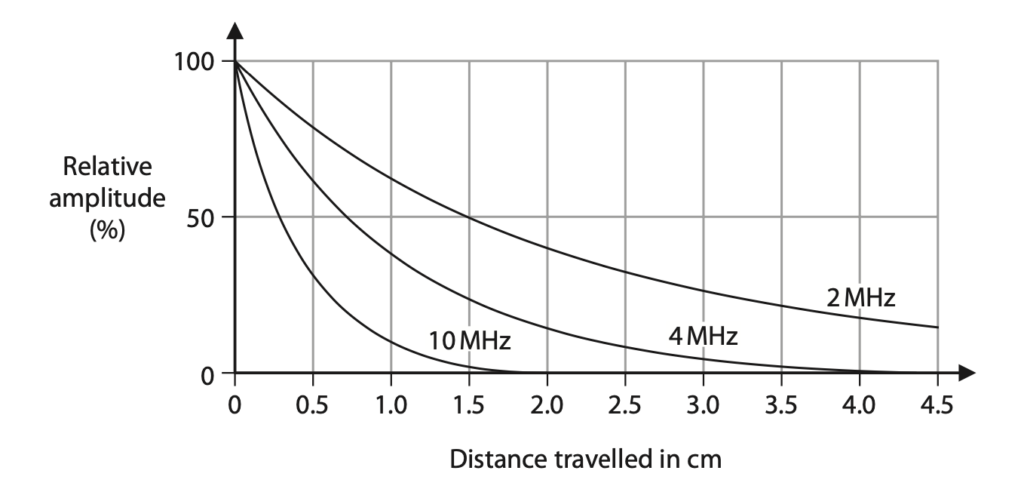
(i) Estimate the distance travelled by a 2 MHz wave when its amplitude is 25% of its original value. (1)
distance = …………………………………………………….. cm
(ii) Describe what the graph shows about the penetrating ability of high frequency sound waves as they travel through soft tissue. (3)
(Total for Question 8 = 9 marks)
2022 Paper 2PR Q3
3 Two students do an experiment to measure the speed of sound in air.
They use two blocks of wood that make a loud noise when hit together.
They do their experiment outside in a wide‐open space.
(a) Describe how the students should use their equipment to measure the speed of sound in air.
You may draw a diagram to support your answer. (5)
(b) The table shows the students’ results. Time in s
| Distance in m | Trial 1 | Trial 2 | Trial 3 | Mean |
| 50 | 0.46 | 0.35 | 0.49 | 0.43 |
| 100 | 0.50 | 0.38 | 0.62 | 0.50 |
| 150 | 0.42 | 0.64 | 0.57 | 0.54 |
| 200 | 0.68 | 0.59 | 0.60 | 0.62 |
| 250 | 0.58 | 0.79 | 0.75 | 0.71 |
| 300 | 0.90 | 0.86 | 0.84 |
(i) Calculate the mean time for the last row in the table. (2)
mean time = ……………………………………….. s
(ii) The students think that some of their time readings are anomalous.
State how the students should deal with these anomalous readings. (1)
(iii) Explain which distance in the table is likely to give the most accurate value for the speed of sound in air. (2)
(Total for Question 3 = 10 marks)
You can find more IGCSE Physics Past Year Questions by the Wave topic below:




